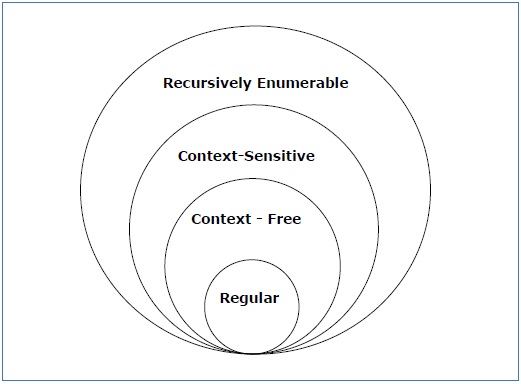
- Automata Theory Tutorial
- Automata Theory - Home
- Automata Theory Introduction
- Deterministic Finite Automaton
- Non-deterministic Finite Automaton
- NDFA to DFA Conversion
- DFA Minimization
- Moore & Mealy Machines
- Classification of Grammars
- Introduction to Grammars
- Language Generated by Grammars
- Chomsky Grammar Classification
- Regular Grammar
- Regular Expressions
- Regular Sets
- Arden's Theorem
- Constructing FA from RE
- Pumping Lemma for Regular Grammar
- DFA Complement
- Context-Free Grammars
- Context-Free Grammar Introduction
- Ambiguity in Grammar
- CFL Closure Properties
- CFG Simplification
- Chomsky Normal Form
- Greibach Normal Form
- Pumping Lemma for CFG
- Pushdown Automata
- Pushdown Automata Introduction
- Pushdown Automata Acceptance
- PDA & Context Free Grammar
- PDA & Parsing
- Turing Machine
- Turing Machine Introduction
- Accepted & Decided Language
- Multi-tape Turing Machine
- Multi-Track Turing Machine
- Non-Deterministic Turing Machine
- Semi-Infinite Tape Turing Machine
- Linear Bounded Automata
- Decidability
- Language Decidability
- Undecidable Language
- Turing Machine Halting Problem
- Rice Theorem
- Post Correspondence Problem
- Automata Theory Useful Resources
- Automata Theory - Quick Guide
- Automata Theory - Useful Resources
- Automata Theory - Discussion
Chomsky Classification of Grammars
According to Noam Chomosky, there are four types of grammars − Type 0, Type 1, Type 2, and Type 3. The following table shows how they differ from each other −
| Grammar Type | Grammar Accepted | Language Accepted | Automaton |
|---|---|---|---|
| Type 0 | Unrestricted grammar | Recursively enumerable language | Turing Machine |
| Type 1 | Context-sensitive grammar | Context-sensitive language | Linear-bounded automaton |
| Type 2 | Context-free grammar | Context-free language | Pushdown automaton |
| Type 3 | Regular grammar | Regular language | Finite state automaton |
Take a look at the following illustration. It shows the scope of each type of grammar −

Type - 3 Grammar
Type-3 grammars generate regular languages. Type-3 grammars must have a single non-terminal on the left-hand side and a right-hand side consisting of a single terminal or single terminal followed by a single non-terminal.
The productions must be in the form X → a or X → aY
where X, Y ∈ N (Non terminal)
and a ∈ T (Terminal)
The rule S → ε is allowed if S does not appear on the right side of any rule.
Example
X → ε X → a | aY Y → b
Type - 2 Grammar
Type-2 grammars generate context-free languages.
The productions must be in the form A → γ
where A ∈ N (Non terminal)
and γ ∈ (T ∪ N)* (String of terminals and non-terminals).
These languages generated by these grammars are be recognized by a non-deterministic pushdown automaton.
Example
S → X a X → a X → aX X → abc X → ε
Type - 1 Grammar
Type-1 grammars generate context-sensitive languages. The productions must be in the form
α A β → α γ β
where A ∈ N (Non-terminal)
and α, β, γ ∈ (T ∪ N)* (Strings of terminals and non-terminals)
The strings α and β may be empty, but γ must be non-empty.
The rule S → ε is allowed if S does not appear on the right side of any rule. The languages generated by these grammars are recognized by a linear bounded automaton.
Example
AB → AbBc A → bcA B → b
Type - 0 Grammar
Type-0 grammars generate recursively enumerable languages. The productions have no restrictions. They are any phase structure grammar including all formal grammars.
They generate the languages that are recognized by a Turing machine.
The productions can be in the form of α → β where α is a string of terminals and nonterminals with at least one non-terminal and α cannot be null. β is a string of terminals and non-terminals.
Example
S → ACaB Bc → acB CB → DB aD → Db